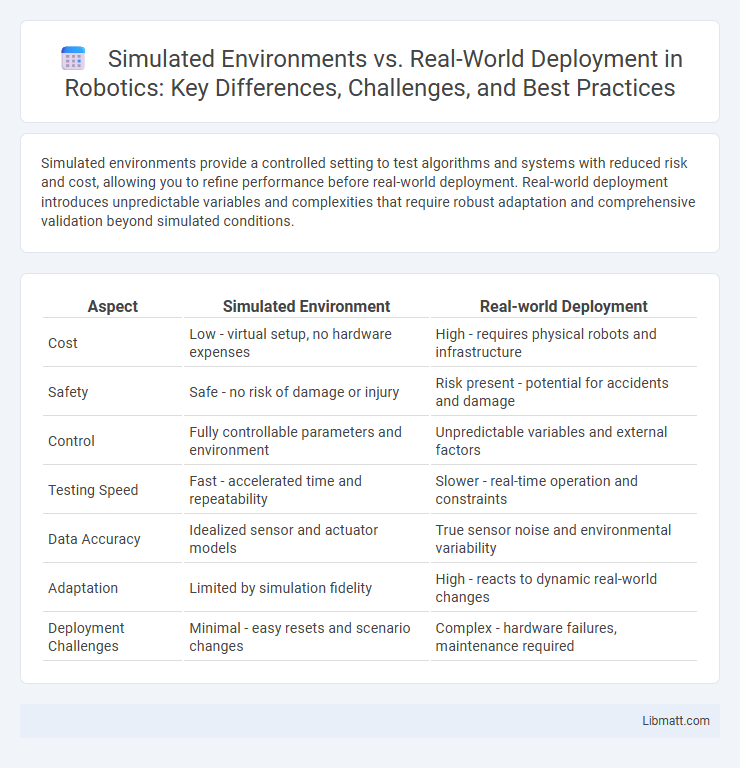Simulated environments provide a controlled setting to test algorithms and systems with reduced risk and cost, allowing you to refine performance before real-world deployment. Real-world deployment introduces unpredictable variables and complexities that require robust adaptation and comprehensive validation beyond simulated conditions.
Table of Comparison
| Aspect | Simulated Environment | Real-world Deployment |
|---|---|---|
| Cost | Low - virtual setup, no hardware expenses | High - requires physical robots and infrastructure |
| Safety | Safe - no risk of damage or injury | Risk present - potential for accidents and damage |
| Control | Fully controllable parameters and environment | Unpredictable variables and external factors |
| Testing Speed | Fast - accelerated time and repeatability | Slower - real-time operation and constraints |
| Data Accuracy | Idealized sensor and actuator models | True sensor noise and environmental variability |
| Adaptation | Limited by simulation fidelity | High - reacts to dynamic real-world changes |
| Deployment Challenges | Minimal - easy resets and scenario changes | Complex - hardware failures, maintenance required |
Introduction to Simulated Environments and Real-world Deployment
Simulated environments offer controlled, cost-effective platforms for testing algorithms, systems, or products by replicating real-world conditions virtually. Real-world deployment involves implementing these solutions in actual operational settings, where unpredictable variables and dynamic interactions challenge system robustness. Balancing insights from simulated environments with real-world feedback is crucial for refining performance and ensuring practical applicability.
Key Differences Between Simulation and Reality
Simulated environments offer controlled, repeatable scenarios ideal for testing algorithms without real-world risks, but they often lack the complexity and unpredictability of real-world deployment. Sensor noise, environmental variability, and unforeseen obstacles present challenges in reality that simulations may not fully capture. Understanding these key differences helps you refine models to better perform when transitioned from virtual testing to practical application.
Advantages of Simulated Environments
Simulated environments offer unparalleled control over variables, enabling precise testing and iteration for AI algorithms without the risks or costs associated with real-world deployment. They facilitate rapid data collection and scenario replication, supporting robust machine learning model training and validation. Your ability to refine systems safely before real-world application accelerates innovation and reduces potential operational failures.
Limitations of Simulations in Real-world Applications
Simulated environments often lack the complexity and unpredictability of real-world conditions, resulting in models that may perform well in theory but fail during actual deployment. Factors such as sensor noise, dynamic obstacles, and environmental variability are difficult to replicate fully, causing discrepancies between simulation outcomes and real-world results. To ensure reliability, You must complement simulations with real-world testing and iterative adjustments tailored to practical challenges.
Real-world Deployment: Benefits and Challenges
Real-world deployment of AI systems offers significant benefits, including exposure to diverse, unpredictable scenarios that improve model robustness and practical applicability. It enables continuous data collection and real-time feedback, facilitating adaptive learning and performance optimization. Challenges involve managing safety risks, ensuring system reliability under variable conditions, and addressing ethical concerns such as privacy and fairness in dynamic environments.
Bridging the Gap: From Simulation to Deployment
Bridging the gap between simulated environments and real-world deployment requires rigorous validation of models against actual conditions to ensure reliability and performance. Integrating sensor data and environmental variability into simulations enhances the fidelity of testing, minimizing discrepancies during deployment. You can improve outcomes by continuously refining simulations based on feedback from real-world operations, ensuring smoother transitions and operational success.
Case Studies: Successes and Failures
Case studies reveal that simulated environments enable rapid prototyping and risk-free testing, exemplified by Tesla's use of virtual simulations to refine Autopilot features before real-world deployment. However, failures like Boeing's 737 MAX highlight the limitations of relying solely on simulations without comprehensive real-world data, leading to critical oversights. Your project benefits from balanced validation in both simulated settings and real-world conditions to ensure robustness and safety.
Risk Assessment in Simulation vs Real Deployment
Risk assessment in simulated environments allows for controlled testing of scenarios without real-world consequences, enabling identification of potential failures and system vulnerabilities with minimal danger. Real-world deployment exposes systems to unpredictable variables and operational risks that simulations may not fully capture, making on-site monitoring and adaptive risk management crucial. You should leverage simulation results to inform risk mitigation strategies while preparing for the complexities and uncertainties inherent in actual deployment contexts.
Future Trends in Simulation and Real-world Testing
Future trends in simulation emphasize increasing fidelity through AI-driven models and enhanced sensor integration to better replicate complex real-world conditions. Real-world deployment continues to benefit from edge computing and 5G connectivity, enabling faster data processing and more adaptive system responses. Integration of digital twins with live data streams is transforming validation methods by providing continuous feedback loops between simulated and actual environments.
Conclusion: Choosing the Right Approach
Selecting between a simulated environment and real-world deployment depends on your project's goals, budget, and risk tolerance. Simulations offer safe, cost-effective testing and rapid iteration, while real-world deployment provides authentic data and practical insights critical for final validation. Balancing these approaches ensures efficient development and reliable performance in actual conditions.
Simulated Environment vs Real-world Deployment Infographic

 libmatt.com
libmatt.com